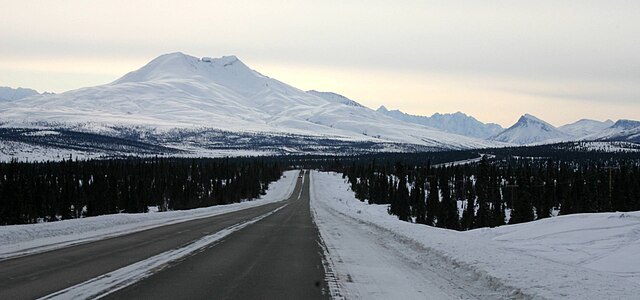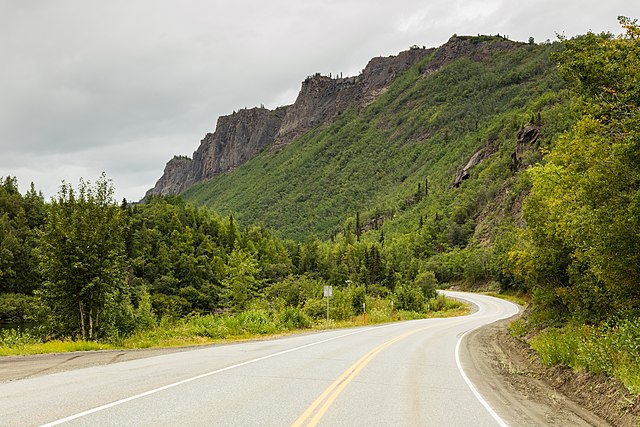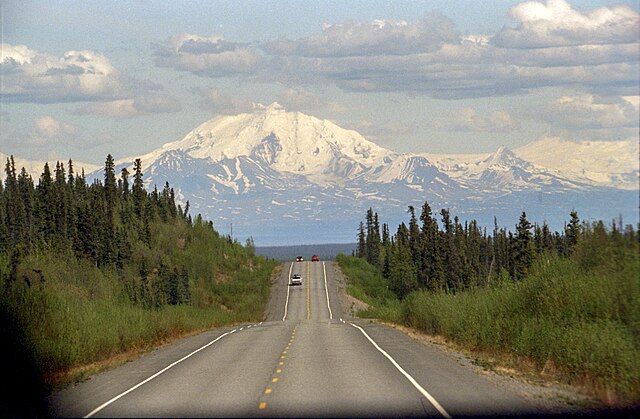Picture this: you’re cruising down a road where snow-capped mountains loom on one side, a braided river sparkles on the other, and glaciers peek out from the horizon like ancient giants. That’s the Glenn Highway in Alaska, a 179-mile stretch of pure, untamed beauty that runs from Anchorage to Glennallen. It’s not just a road—it’s a journey through Alaska’s heart, where every mile tells a story of rugged wilderness, rich history, and adventure waiting around the next bend. Whether you’re a road trip enthusiast, a nature lover, or just curious about Alaska’s wild side, the Glenn Highway is calling your name. Let’s dive into what makes this National Scenic Byway a must-see, shall we?
Why the Glenn Highway Should Be on Your Bucket List
Why bother with the Glenn Highway when Alaska has so many epic drives? Simple: it’s a perfect blend of accessibility and awe. Stretching from the hustle of Anchorage to the quiet outpost of Glennallen, this highway offers a front-row seat to Alaska’s most dramatic landscapes—think towering peaks, sprawling glaciers, and rivers that twist like ribbons across the valley. It’s a designated National Scenic Byway for a reason, and trust me, the views alone are worth the gas. Plus, it’s not just about the scenery. The Glenn Highway is steeped in history, dotted with quirky stops, and packed with outdoor activities that’ll make your heart race. Ready to see what’s in store?
A Brief History of the Glenn Highway
The Glenn Highway wasn’t always the smooth, paved road it is today. Back in the 1930s, it started as the Palmer Road, a humble path connecting Anchorage to the agricultural hub of Palmer. During World War II, the U.S. military saw the need for better access to the interior, so they extended it all the way to Glennallen, linking it to the broader Alaska Highway system. Named after Captain Edwin Glenn, who explored routes to the Klondike gold fields in the 1890s, this highway became a lifeline for military bases and a gateway for adventurers. By the 1950s, it was paved, and today, it’s one of Alaska’s most iconic drives. Knowing this history makes every mile feel like a step back in time, don’t you think?
The Route: From Anchorage to Glennallen
Starting in Anchorage, Alaska’s biggest city, the Glenn Highway (part of Alaska Route 1) stretches 179 miles northeast to Glennallen, where it meets the Richardson Highway. If you include the Tok Cut-Off, it’s a whopping 328 miles to Tok, but most folks stick to the core Anchorage-to-Glennallen stretch. The first 38 miles, from Anchorage to Wasilla, are Alaska’s longest freeway, bustling with suburban traffic. But once you pass Palmer, the road opens up, and the wilderness takes over. You’ll wind through the Matanuska Valley, skirt the Chugach Mountains, and hit the highest point at Eureka Summit (3,332 feet). It’s like driving through a postcard—every turn is a new masterpiece.
Stunning Landscapes That’ll Leave You Speechless

The Glenn Highway is like a love letter to Alaska’s wild beauty. The Matanuska River, a braided beauty fed by glaciers, runs parallel to the road for over half its length, its waters glinting under the sun. To the south, the Chugach Mountains stand tall, their peaks dusted with snow even in summer. To the north, the Talkeetna Mountains add their own rugged charm. And then there’s the Nelchina Glacier, a frozen giant that flows out of the Chugach range, reminding you just how raw this place is. Whether it’s the vibrant fall colors in September or the Northern Lights dancing in winter, the scenery here is a feast for the eyes. Can you imagine pulling over just to soak it all in?
Matanuska Glacier: The Star of the Show
At mile 102, you’ll find the crown jewel of the Glenn Highway: the Matanuska Glacier. This massive ice sheet, stretching 27 miles long and 4 miles wide, is Alaska’s largest glacier accessible by car. You can pull over at the Matanuska Glacier State Recreation Site (mile 101) for a free, jaw-dropping view, or head to Glacier Park at mile 102 for a closer look. Imagine standing at the foot of a glacier, its icy blue crevasses glowing in the sunlight, while you snap a selfie that’ll make your friends jealous. Guided tours let you walk on the ice or even try ice climbing—talk about a bucket-list moment!
Tips for Visiting Matanuska Glacier
Planning to visit the glacier? Wear sturdy shoes—those icy paths can be slippery. If you’re going with a tour, book ahead, especially in summer when spots fill up fast. Bring layers, too; the glacier’s chilly even when the sun’s out. And don’t forget your camera—the photo ops here are unreal. If you’re not up for a trek, the viewpoint at mile 102 offers plenty of parking and interpretive signs about glaciers and local wildlife. It’s like a mini science lesson with a side of stunning views.
Outdoor Adventures Along the Glenn Highway
The Glenn Highway isn’t just for driving—it’s a playground for outdoor enthusiasts. From hiking to rafting to snowmachining, there’s something for every adrenaline junkie. The highway’s proximity to Chugach State Park and its 500,000 acres of trails makes it a hiker’s paradise. Want to paddle? The Matanuska River’s Class III rapids are perfect for rafting. Fishing fans can cast a line in alpine lakes or river bends, while winter brings snowmachining and cross-country skiing. Whatever your vibe, the Glenn Highway’s got you covered. What’s your kind of adventure?
Hiking Trails to Explore
Love a good hike? The Glenn Highway has trails for every skill level. Near mile 102, a short hike from Glacier Park lets you touch the Matanuska Glacier—how cool is that? For something more challenging, try the trails around Eureka Summit, where rugged paths lead to sweeping views of the Chugach and Talkeetna ranges. The Caribou Creek Recreational Mining Area at mile 104 offers a unique twist: you can pan for gold after a steep half-mile trek. It’s not about getting rich—it’s about feeling like a prospector for a day. Which trail would you pick?
Rafting and Kayaking on the Matanuska River
The Matanuska River isn’t just pretty—it’s a thrill-seeker’s dream. Its fast, cold waters, fed by the glacier, offer Class III rapids that’ll get your heart pumping. Companies like AK Paddlesports rent kayaks, canoes, and paddleboards, so you can tackle the river at your own pace. If you’re new to rafting, guided trips are the way to go—they’ll keep you safe while you navigate the twists and turns. Paddling through a glacial valley with mountains all around? It’s like starring in your own adventure movie.
Quirky Stops and Hidden Gems
Beyond the big-ticket views, the Glenn Highway is dotted with quirky stops that add character to your trip. In Palmer, check out the Musk Ox Farm, where you can meet these shaggy beasts and learn about their super-warm qiviut wool. At mile 159.8, take a detour to Lake Louise for fishing, boating, or just chilling by the water. And don’t miss the Eureka Roadhouse, a classic Alaskan stop with hearty food and a vibe that screams “frontier.” These little gems make the drive feel like a treasure hunt, don’t they?
Palmer: Alaska’s Agricultural Heart
Palmer, about 42 miles from Anchorage, is a must-stop. This small town is famous for its fertile Matanuska Valley soil, which grows record-breaking veggies—think cabbages the size of beach balls. The Alaska State Fair, held every August, is a blast, with giant produce displays, rides, and local crafts. Pop into the Colony House Museum to learn about the 1930s farming colony that put Palmer on the map. It’s like stepping into a slice of Alaska’s past, with a side of small-town charm.
Why Visit the Alaska State Fair?
If you’re driving the Glenn Highway in late summer, the Alaska State Fair is a no-brainer. Held at the fairgrounds in Palmer, it’s a celebration of all things Alaskan—think fresh-baked pies, live music, and those massive veggies. It’s family-friendly, with rides for kids and craft beer for adults. Pro tip: try the local salmon chowder. It’s a warm hug in a bowl, perfect for a chilly Alaskan evening.
Wildlife and Nature: What to Spot
The Glenn Highway is a wildlife lover’s paradise. Keep your eyes peeled for moose grazing along the road, bald eagles soaring overhead, or even Dall sheep on the slopes of Sheep Mountain (mile 113). The braided Matanuska River attracts salmon, which in turn draw bears—especially in late summer. Pullouts along the highway offer safe spots to scan for wildlife, but always keep your distance (and maybe bring binoculars). Spotting a bear fishing in the river? That’s the kind of moment that makes you feel alive.
Best Spots for Wildlife Viewing
For the best wildlife sightings, stop at the pullouts near Long Lake or the Matanuska Glacier viewpoints. These spots offer unobstructed views of the river and surrounding forests, where animals often roam. Early morning or dusk is prime time for spotting moose or bears. And if you’re lucky enough to visit in winter, the Northern Lights might just steal the show, dancing across the sky above the snow-draped peaks. Can you imagine anything more magical?
Seasonal Highlights: When to Drive

The Glenn Highway is a year-round stunner, but each season offers something unique. Summer (June to August) brings long days, wildflowers, and endless outdoor fun. Fall (September) paints the landscape in vibrant golds and reds, especially around Eureka Summit. Winter (November to March) is a wonderland of snow, ice, and Northern Lights, though you’ll need to drive carefully. Spring (April to May) is quieter, with melting snow revealing fresh greenery. Whenever you go, the highway delivers—what’s your favorite season for a road trip?
Winter Driving Tips
Winter on the Glenn Highway is no joke. Snow and ice can make the road slick, especially around Eureka Summit. Check road conditions on 511.alaska.gov before you head out, and make sure your car has winter tires and an emergency kit. Drive slowly, especially in slide-prone areas like Long Lake, where boulders sometimes tumble onto the road. But don’t let the cold scare you—the Northern Lights and snowy vistas are worth the extra prep.
Planning Your Glenn Highway Adventure
Ready to hit the road? Plan for at least a full day to drive the Glenn Highway, though two or three days let you explore more stops. Start early to beat the crowds, especially at popular spots like Matanuska Glacier. Pack snacks, water, and a good playlist—cell service can be spotty. Gas up in Anchorage or Palmer, as fuel stations are scarce past Glennallen. And don’t forget a map or GPS; the highway’s straightforward, but side roads can be tricky. Where will your first stop be?
Where to Stay and Eat
Along the Glenn Highway, you’ll find cozy lodges and campgrounds for every budget. In Palmer, try the Fox Run Lodge for RV camping or hotel rooms. Near Glennallen, the Caribou Hotel offers a warm bed and hearty meals. For a rustic vibe, the Eureka Roadhouse serves up burgers and local stories. If camping’s your thing, check out the Dry Creek State Recreation Site (mile 192) or Lake Louise Recreation Area. Nothing beats a campfire under the Alaskan stars, right?
Challenges and Preservation Efforts
The Glenn Highway isn’t without its challenges. Erosion from the Matanuska River has caused headaches, like in June 2024 when it undercut a section near Sutton, forcing emergency repairs. The Alaska Department of Transportation works hard to keep the road safe, with ongoing projects like the 2026-2031 rehabilitation to resurface and improve safety. These efforts ensure the highway stays open for future adventurers, but they can mean detours or delays. Checking road updates before you go is a smart move.
How You Can Help Preserve the Highway
Want to keep the Glenn Highway pristine? Stick to designated trails to avoid damaging fragile ecosystems. Pack out all trash, and respect wildlife by keeping your distance. Support local businesses like AK Paddlesports or the Musk Ox Farm—they reinvest in the community and help maintain Alaska’s wild spaces. Every little bit helps keep this scenic gem shining for years to come.
Conclusion: Your Glenn Highway Adventure Awaits
The Glenn Highway is more than a road—it’s a journey into Alaska’s soul. From the icy majesty of the Matanuska Glacier to the quirky charm of Palmer’s giant veggies, every mile offers something to marvel at. Whether you’re chasing adventure, history, or just a killer view, this National Scenic Byway delivers in spades. So grab your keys, pack your sense of wonder, and hit the road. The Glenn Highway is waiting to show you why Alaska is called the Last Frontier. Where will it take you?
Frequently Asked Questions
1. How long does it take to drive the Glenn Highway?
Driving the 179-mile stretch from Anchorage to Glennallen takes about 3.5 hours without stops. Add time for sightseeing, hikes, or glacier tours—plan a full day or more for the full experience.
2. Is the Glenn Highway safe to drive in winter?
Yes, but it requires caution. Snow and ice are common, especially at Eureka Summit. Check 511.alaska.gov for road conditions, use winter tires, and carry an emergency kit.
3. Can I visit the Matanuska Glacier without a guided tour?
You can view the glacier from the Matanuska Glacier State Recreation Site at mile 101 for free. To walk on the glacier, you’ll need to access it via Glacier Park at mile 102, which requires a fee or guided tour.
4. What’s the best time of year to drive the Glenn Highway?
Summer (June-August) offers long days and mild weather, while September brings stunning fall colors. Winter (November-March) is great for Northern Lights but demands careful driving.
5. Are there places to eat along the Glenn Highway?
Yes! Stop at the Eureka Roadhouse for classic Alaskan fare, the Noisy Goose Cafe in Palmer for breakfast, or the Caribou Hotel in Glennallen for a hearty meal.

